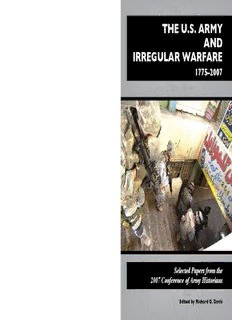
THE U.S. ARMY AND IRREGULAR WARFARE - United States Army PDF
Preview THE U.S. ARMY AND IRREGULAR WARFARE - United States Army
T H THE U.S. ARMY E U . S AND . A R M IRREGULAR WARFARE Y A N 1775–2007 D I R R E G U L A R W A R F A Proceedings of the Fifth Workshop of the Partnership for R Peace Consortium’s Military History Working Group E , 1 7 7 5 – 2 0 0 7 C e n t e U r o n f M ite Selected Papers from the d ilit S 2007 Conference of Army Historians a t r a y t e H s is A t r o m PIN : 085002–000 r Edited by Richard G. Davis y y THE U.S. ARMY AND IRREGULAR WARFARE, 1775–2007 Selected Papers from the 2007 Conference of Army Historians Edited by Richard G. Davis CENTER OF MILITARY HISTORY UNITED STATES ARMY WASHINGTON, D.C., 2008 Library of Congress Cataloging-in-Publication Data Conference of Army Historians (16th : 2007) The U.S. Army and irregular warfare, 1775–2007 : selected papers from the 2007 Conference of Army Historians / edited by Richard G. Davis. p. cm. 1. Special forces (Military science)—United States—History— Congresses. 2. Counterinsurgency—United States—History—Congresses. 3. Guerrilla warfare—United States—History—Congresses. I. Davis, Richard G. II. Title. UA34.C66 2007 355.02’180973—dc22 2008026508 First Printing CMH Pub 70–111–1 Contents Page Foreword .................................................. v The U.S. Army and Irregular Warfare, 1775–2007 Introduction ................................................ 1 Part One—Non-American Counterinsurgency Operations The Roar of Lions: The Asymmetric Campaigns of Muhammad, Russell G. Rodgers ....................................... 15 Southern (Dis)Comfort: British Phase IV Operations in South Carolina and Georgia, May–September 1780, Steven J. Rauch ............ 33 When Freedom Wore a Red Coat: How Cornwallis’ 1781 Virginia Campaign Threatened the Revolution in Virginia, Gregory J. W. Urwin ..................................... 59 Learning the Good and the Bad: Canadian Exposure to British Small War Doctrine in South Africa, 1900–1901, Chris Madsen ........ 89 Blindness and Contingencies: Italian Failure in Ethiopia (1936–1940), Richard Carrier ......................................... 107 The Roots of Dutch Counterinsurgency: Balancing and Integrating Military and Civilian Efforts from Aceh to Uruzgan, Thijs W. Brocades Zaalberg ................................ 119 Part Two—Special Aspects of Irregular Warfare The History of Military Commissions in the U.S. Army: From the Mexican-American War to the War on Terrorism, Frederic L. Borch ........................................ 133 Intimidation, Provocation, Conspiracy, and Intrigue: The Militias of Kentucky, 1859–1861, John A. Boyd ......................... 145 The Spoliation of Defenseless Farmers and Villagers: The Long-Term Effects of John Hunt Morgan’s Raid on an Indiana Community, Stephen I. Rockenbach .................................... 161 Irregular Engineers: The Use of Indigenous Labor in the Rebuilding of Critical Infrastructure During the Korean War, 1950–1953, Eric A. Sibul ............................................ 171 iii Page Part Three—U.S. Counterinsurgency Operations The Victorio Campaign: Hunting Down an Elusive Enemy, Kendall D. Gott ......................................... 183 Without the Need of a Single American Rifleman: James Van Fleet and His Lessons Learned as Commander of the Joint United States Military Advisory and Planning Group During the Greek Civil War, 1948–1949, Robert M. Mages .............................. 195 Chasing a Chameleon: The U.S. Army Counterinsurgency Experience in Korea, 1945–1952, Mark J. Reardon ....................... 213 Lessons Learned and Relearned: Gun Trucks on Route 19 in Vietnam, Ted Ballard ............................................. 229 Some Observations on Americans Advising Indigenous Forces, Robert D. Ramsey III ..................................... 239 Contributors ............................................... 249 iv Foreword Using the theme “The U.S. Army and Irregular Warfare, 1775–2007,” the 2007 Conference of Army Historians featured over sixty formal papers exploring the nature of unconventional warfare and its significance throughout history. The event also included several workshops and sessions on administra- tive issues of common concern across the Army historical community and much informal discussion and networking. From the opening of the conference to the final dinner, where U.S. Army Vice Chief of Staff General Richard A. Cody addressed the current operating environment and answered hard questions from the audience about the future, the conference informed participants about differing aspects of the type of warfare confronting the U.S. Army in the Global War on Terrorism today. The fifteen papers selected for this publication are not only the best of those presented, but they also examine irregular warfare in a wide and diverse range of circumstances and eras. Together, they demonstrate how extremism was intimately connected to this type of warfare and how Americans have, at different times in their history, found themselves acting as insurgents, counterinsurgents, or both. The titles of the papers themselves reflect how often the U.S. Army has engaged in such irregular operations despite a formal focus on conventional warfare. Using imperial British and Italian examples, several presentations also underline how the ease of conquering lands is often no indication of the level of effort required to pacify them and integrate them into a larger whole. Each paper provides useful insights to the reader, soldiers and historians alike. I hope that after you have finished with this collection you will continue to broaden your knowledge of military history by turning to the U.S. Army Center of Military History (CMH) Web site (http://www.history.army.mil/) and by examining the Center’s many publications and other features highlighting the 233-year history of our Army. Washington, D.C. JEFFREY J. CLARKE 1 August 2008 Chief of Military History v The U.S. Army and Irregular Warfare 1775–2007
Description: